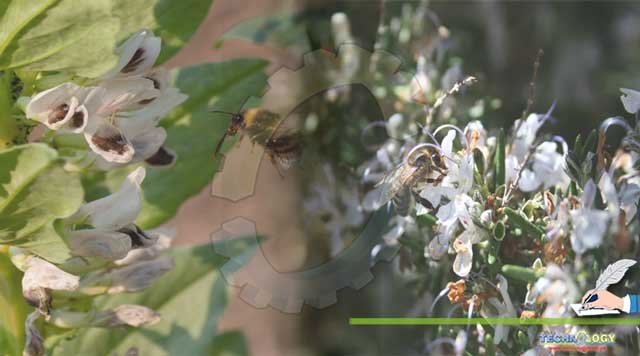Plant species, their relationships, and entire ecosystems can all be affected by global warming. Elevated temperatures, for example, can cause phenological changes in plants across communities and alter plant-pollinator interaction networks.

By Danyal Haider Khan , Usama Fareed, Nimra Batool, Rimsha Irshad
Effects of Temperature Stress on Flower’s nectar:
Plant nectar production is one element of plant–pollinator interactions that is particularly vulnerable to climate change. Plant nectar production can often benefit from a small increase in average temperature, but beyond that, plants undergo temperature stress, which can cause nectar output to alter. Under both experimental and natural situations, a number of studies from various systems have revealed lower nectar quantities and nectar production rates at higher temperatures. During the flowering season, nectar sugar content is less affected by external influences and is more consistent throughout the day. Despite the fact that the quantity of sugar generated per flower is determined by nectar volume rather than concentration, variations in ambient temperatures have a significant impact.
Reduced nectar quantity and sugar content as a result of global warming lowers the amount of resources accessible to pollinators, which might negatively impact plant–pollinator interactions. Plants can even begin to produce flowers without nectar when exposed to extreme temperatures, reducing the quantity of resources available. Pollinator behaviour patterns can be influenced by a reduction in floral rewards, as well as variance in nectar production patterns within a plant. Pollinators are frequently reported to be risk-sensitive to increased nectar volume fluctuation, and excessive variance can therefore reduce pollinator appeal. As a result of altered pollinator interaction patterns, climate change may impair plant reproductive success, thereby jeopardising the survival of both plant and pollinator populations.
Effects of Temperature Stress on Flower’s Pollen:
Because B. acetabulosa is more sensitive to high temperatures, the impact of climate change on pollinators of this species might be more evident in the coming decades, even if the warming is modest. Although plant–pollinator networks, particularly generalist relationships, are predicted to be somewhat resilient to climate change, the extinction of a generalist plant species might nevertheless pose a significant threat to pollinator population persistence. Even if plant and pollinator populations are able to endure for a period of time, the intensity of connections can be altered due to changes in plant resources and pollinator behaviour, and so global warming can still have a substantial impact on mutualistic interaction networks.
Furthermore, under increased temperatures, experimental warming in the climate box hastened plant blooming and thereby shortened the length of the flowering period. In natural settings, shorter blooming times as a result of global warming may increase the likelihood of pollinator temporal mismatches. Because the Lamiaceae family is the most important pollinator group in phryganic systems in the summer, decreased nectar secretion and timing mismatches with these species at extremely high temperatures might have a significant influence on the phryganic pollinator fauna. Furthermore, it has the potential to harm apiculture in the Mediterranean, which is heavily reliant on the quantity and nectar production of Lamiaceae species in phryganic systems.
Anthers and pollen are more susceptible to HT than ovules within a floret, and floret sterility at temperatures below 30 °C has been linked to decreased anther dehiscence, pollen grain formation, pollen sterility, and in vivo pollen germination. Grain counts and weight are two yield components that are negatively impacted by HT after fertilisation and contribute to HI. Increased night temperatures, in particular, increase the HT response on morphological components that affect yield. Despite the significance of HT’s detrimental impact on cereal crop yields, the molecular processes governing yield decreases in grasses during HT have yet to be fully understood. High temperature (HT) stress throughout the reproductive phases of crop growth can drastically reduce plant yield components. Pollen growth during various stages of microsporogenesis in soybean was found to be susceptible to HT stress in many studies as crops in future climates are predicted to be exposed not only to higher mean temperatures but also to more Pollen growth during various stages of microsporogenesis in soybean was found to be susceptible to HT stress in many studies. The influence of HT on pollen morphological alterations in soybeans has only been studied in a few studies. HT stress had a greater influence on soybean pollen morphology, especially in temperature-sensitive genotypes. Pollen viability was decreased under HT stress conditions due to pollen grains that had altered form (flattened and collapsed). Due to HT stress during reproductive development, soybeans developed a similar deformed exine with severely pitted and smooth regions. Because exine originates from the tapetum cells, the altered pollen morphology might be linked to changes in the tapetal layer..
Effects of Temperature Stress on Flower’s Suger concentration:
Floral nectar compositions, as well as the pollinators that consume them. Hummingbirds and hawkmoths, for example, pollinate sucrose-rich blooms, whereas flies and bats fertilise sucrose-deficient flowers. The sugar content of a species has long been thought to be able to be determined from a few samples, however there is little evidence to back up this claim. Few studies have looked for statistically significant variations in nectar sugar composition in species with wide geographic or elevational ranges, and the existence and magnitude of variations in nectar sugar composition within single populations during growing seasons have not been adequately investigated. Under field conditions, however, nectars from soybeans (Glycine max) have been discovered to be very varied. Water stress was thought to be the cause of variations in carbohydrate content over the course of a study year. While the sugar content of individual flowers’ nectars did not change with floral age in a field population of Ipomopsis longiflora, the nectar sugar composition of individual plants did alter to a minor but statistically significant degree over the flowering period. Since the sample dates with the lowest % sucrose composition corresponded with the warmest and driest portion of the growth season, this fluctuation was suggested to be connected to the impacts of temperature or water stress.
Authors: Danyal Haider Khan , Usama Fareed, Nimra Batool, Rimsha Irshad